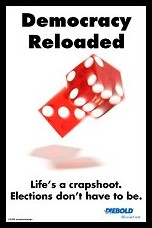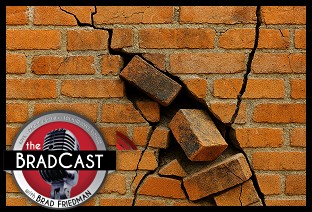Guest blogged by Ernest A. Canning
• UPDATED 2:59pm PT with additional reporting from Brad Friedman
 With 100% of the precincts now reporting unofficial results, Assistant Attorney General JoAnne Kloppenburg leads Justice David Prosser by a remarkably thin 204 votes out of some 1.5 million ballots cast in the Wisconsin Supreme Court race --- according to the computers that count votes in the state.
With 100% of the precincts now reporting unofficial results, Assistant Attorney General JoAnne Kloppenburg leads Justice David Prosser by a remarkably thin 204 votes out of some 1.5 million ballots cast in the Wisconsin Supreme Court race --- according to the computers that count votes in the state.
The unofficial numbers at this hour, according to AP's spreadsheet of those computer results, give Kloppenburg 740,090 votes to Prosser's 739,886.
Despite Kloppenburg's tiny reported lead, the race is virtual dead heat in what might otherwise be a little-noticed state Supreme Court election. The race, however, has been turned into a proxy battle between supporters of the state's controversial new Republican Gov. Scott Walker (who Prosser has allied himself with) and union workers and their supporters who oppose Walker and the state GOP's attempt to legislate away the freedom of citizens to collectively bargain through public worker unions. Outside groups, according to NYU's Brennan Center for Justice, are said to have spent a record $3.5 million on so-called "issue ads" to support their favored candidate in the closing days of the election.
For proponents of Election Integrity, there is both good news and bad in the Badger State. The good news: most of the state's voters used verifiable hand-marked paper ballots to record their votes yesterday. The bad news: Those ballots are counted by easily-manipulated, oft-failed computers instead of human beings; 100% unverifiable Direct Recording Electronic (DRE, usually touch-screen) voting machines are used by some voters with disabilities across the state; and, given close results, even if a hand-count of paper ballots occurs, as is likely, the number of votes cast on unverifiable DREs could end up being larger than the final margin between the two candidates --- meaning that it will be, literally, impossible to know for certain who actually won the election...
WI has approved unverifiable DREs for use, usually by disabled voters who choose to do so, as made by Diebold, ES&S, Sequoia & Populex. Study after study --- as well as in real-life elections --- have demonstrated that the touch-screen systems made by all of those companies can be easily hacked. The systems are often unreliable, with a propensity for flipping votes both on the screen and invisibly inside the system, as well as simply failing to register votes at all on many occasions.
If, after a state-wide hand-count of paper ballots, the number of votes cast on DRE systems in the state is larger than the final margin between Prosser and Kloppenburg, the results will end up being 100% faith-based, with blind faith in the invisible ballots cast on Diebold, ES&S, Sequoia and Populex DREs being necessary to regard the election as legitimate.
Compounding the problem is that, while use of DREs in counties with paper ballots for most voters is usually quite low, many precincts across the state were said to have run short of ballots yesterday with the much higher than anticipated turnout. Some precincts, it has been reported (though not yet confirmed, as of now), were forced to direct voters to vote on DREs instead of on paper when ballots had run short.
On the brighter side of the equation, it is possible to verify who received the most votes at least where hand-marked paper ballots were used. Presuming the chain of custody for those paper ballots is secure (not always a safe assumption, naturally) a transparent public hand-count of those ballots should yield reliable results. Had they been counted by humans last night, at the precinct, in front of the citizenry and video cameras, before ballots were sent back to a central counting location --- as per Democracy's Gold Standard --- chain of custody concerns would not have been as much of an issue.
Where optical-scan counters made by most of the same companies mentioned above were used either at the precinct or at a central location (for example, with absentee ballots) last night, the results reported at this hour are either accurate --- or not accurate. Only a hand-count of those paper ballots, one that is likely to happen given the tightness of the race (and a statement this morning from Prosser's campaign), can answer that question.
According to Wisconsin's recount procedures manual [PDF], "ballots may not be hand counted without a court order," as per Wis. Stat. § 5.90(2). That said, however, the procedures also allow "Each ballot shall be reviewed by the board of canvassers and may be inspected by the candidates or their representatives before being fed into the machine." So a 'virtual hand-count', of sorts, can take place whether court-ordered or not, as we read the state's rules on this.
 In 2006, Wisconsin approved op-scan systems such as the Diebold AccuVote OS for use in the state's precincts. That year, they also approved the use of the ES&S M100 for op-scanning ballots.
In 2006, Wisconsin approved op-scan systems such as the Diebold AccuVote OS for use in the state's precincts. That year, they also approved the use of the ES&S M100 for op-scanning ballots.
As The BRAD BLOG has previously reported the ES&S M100 scanner was found, according to a letter sent to the U.S. Election Assistance Commission (EAC) by a county in MI, to have failed pre-election "logic and accuracy testing" in a number of cases. According to the same letter, the M-100 "reported inconsistent vote totals", such that "The same ballots run through the same machines, yielded different results each time."
The Diebold AccuVote OS is legendary for being simple to manipulate in such a way that only a hand-count of ballots can ensure that ballots tabulated on it were accurately recorded. The vulnerabilities of that system were startlingly revealed for the first time during a 2005 mock election in Leon County, FL which was captured on film and shown in the climactic final scene of Emmy-nominated 2006 HBO documentary Hacking Democracy.
In that test, the results reported by the Diebold system were the complete opposite of what the paper ballots themselves had recorded. Only a hand-count of ballots tabulated by such machines is able to reveal the true results of the election.
You can watch that remarkable landmark hack, as it happened in real time, in the scene from Hacking Democracy as posted below (appx 9 mins)...
UPDATE 2:55 p.m. PT: Relying upon the computer count, Kloppenburg declared victory, stating:


 SCOTUS Ruling a How-To for Unlawful Gerrymandering on 'Eve' of Critical Election Year: BradCast' 12/17/25
SCOTUS Ruling a How-To for Unlawful Gerrymandering on 'Eve' of Critical Election Year: BradCast' 12/17/25 Bricks in the Wall:
Bricks in the Wall: 'Green News Report' 12/16/25
'Green News Report' 12/16/25
 'This One Goes to 11': Weekend of Violence, Tragic Murder of Rob Reiner: 'BradCast' 12/15
'This One Goes to 11': Weekend of Violence, Tragic Murder of Rob Reiner: 'BradCast' 12/15 Sunday 'WTF?' Toons
Sunday 'WTF?' Toons Trump Now Losing One
Trump Now Losing One 'Green News Report' 12/11/25
'Green News Report' 12/11/25 Dems Continue Stunning 2025 Election Streak: 'BradCast' 12/10/25
Dems Continue Stunning 2025 Election Streak: 'BradCast' 12/10/25 Petrostates and Propagandists Undermining Climate Science: 'BradCast' 12/9/25
Petrostates and Propagandists Undermining Climate Science: 'BradCast' 12/9/25 'Green News Report' 12/9/25
'Green News Report' 12/9/25 The High Cost of Trump's Terrible Policy Making: 'BradCast' 12/8/25
The High Cost of Trump's Terrible Policy Making: 'BradCast' 12/8/25 Sunday 'All in a Day's Work' Toons
Sunday 'All in a Day's Work' Toons Dems Fight to Avoid the GOP's Massive, Year-End Health Care Cliff: 'BradCast' 12/4/25
Dems Fight to Avoid the GOP's Massive, Year-End Health Care Cliff: 'BradCast' 12/4/25 'Green News Report' 12/4/25
'Green News Report' 12/4/25 A 'Flashing Red Warning Sign' for GOP: 'BradCast' 12/3/25
A 'Flashing Red Warning Sign' for GOP: 'BradCast' 12/3/25 Hegseth, War Crimes and DoD's 'Politicization Death Spiral': 'BradCast' 12/2/25
Hegseth, War Crimes and DoD's 'Politicization Death Spiral': 'BradCast' 12/2/25 Follow the
Follow the  With Thanks, No Kings and Good Cheer
With Thanks, No Kings and Good Cheer Presidential Illegality and Duty to Disobey
Presidential Illegality and Duty to Disobey President of United States Calls for Killing Democratic Officials: 'BradCast' 11/20/25
President of United States Calls for Killing Democratic Officials: 'BradCast' 11/20/25 Is MAGA Finally Beginning to Fall Apart?: 'BradCast' 11/19/25
Is MAGA Finally Beginning to Fall Apart?: 'BradCast' 11/19/25 Trump's Terrible, Horrible, No Good, Very Bad Week: 'BradCast' 11/18/25
Trump's Terrible, Horrible, No Good, Very Bad Week: 'BradCast' 11/18/25
 VA GOP VOTER REG FRAUDSTER OFF HOOK
VA GOP VOTER REG FRAUDSTER OFF HOOK Criminal GOP Voter Registration Fraud Probe Expanding in VA
Criminal GOP Voter Registration Fraud Probe Expanding in VA DOJ PROBE SOUGHT AFTER VA ARREST
DOJ PROBE SOUGHT AFTER VA ARREST Arrest in VA: GOP Voter Reg Scandal Widens
Arrest in VA: GOP Voter Reg Scandal Widens ALL TOGETHER: ROVE, SPROUL, KOCHS, RNC
ALL TOGETHER: ROVE, SPROUL, KOCHS, RNC LATimes: RNC's 'Fired' Sproul Working for Repubs in 'as Many as 30 States'
LATimes: RNC's 'Fired' Sproul Working for Repubs in 'as Many as 30 States' 'Fired' Sproul Group 'Cloned', Still Working for Republicans in At Least 10 States
'Fired' Sproul Group 'Cloned', Still Working for Republicans in At Least 10 States FINALLY: FOX ON GOP REG FRAUD SCANDAL
FINALLY: FOX ON GOP REG FRAUD SCANDAL COLORADO FOLLOWS FLORIDA WITH GOP CRIMINAL INVESTIGATION
COLORADO FOLLOWS FLORIDA WITH GOP CRIMINAL INVESTIGATION CRIMINAL PROBE LAUNCHED INTO GOP VOTER REGISTRATION FRAUD SCANDAL IN FL
CRIMINAL PROBE LAUNCHED INTO GOP VOTER REGISTRATION FRAUD SCANDAL IN FL Brad Breaks PA Photo ID & GOP Registration Fraud Scandal News on Hartmann TV
Brad Breaks PA Photo ID & GOP Registration Fraud Scandal News on Hartmann TV  CAUGHT ON TAPE: COORDINATED NATIONWIDE GOP VOTER REG SCAM
CAUGHT ON TAPE: COORDINATED NATIONWIDE GOP VOTER REG SCAM CRIMINAL ELECTION FRAUD COMPLAINT FILED AGAINST GOP 'FRAUD' FIRM
CRIMINAL ELECTION FRAUD COMPLAINT FILED AGAINST GOP 'FRAUD' FIRM RICK SCOTT GETS ROLLED IN GOP REGISTRATION FRAUD SCANDAL
RICK SCOTT GETS ROLLED IN GOP REGISTRATION FRAUD SCANDAL VIDEO: Brad Breaks GOP Reg Fraud Scandal on Hartmann TV
VIDEO: Brad Breaks GOP Reg Fraud Scandal on Hartmann TV RNC FIRES NATIONAL VOTER REGISTRATION FIRM FOR FRAUD
RNC FIRES NATIONAL VOTER REGISTRATION FIRM FOR FRAUD EXCLUSIVE: Intvw w/ FL Official Who First Discovered GOP Reg Fraud
EXCLUSIVE: Intvw w/ FL Official Who First Discovered GOP Reg Fraud GOP REGISTRATION FRAUD FOUND IN FL
GOP REGISTRATION FRAUD FOUND IN FL

































